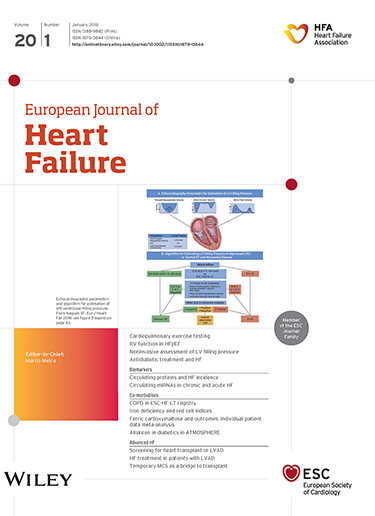一项多中心、随机、双盲、有效和安慰剂对照的研究:佩卡帕坦是一种双重V1a/V2抗利尿激素受体拮抗剂,用于急性心力衰竭患者:AVANTI试验。
IF 10.8
1区 医学
Q1 CARDIAC & CARDIOVASCULAR SYSTEMS
引用次数: 0
摘要
平衡的双重抗利尿激素受体拮抗剂作为循环利尿治疗的辅助和/或替代疗法可能具有潜在的优势。方法和结果savanti是一项双盲、随机试验,在心力衰竭和残余充血住院患者中进行。在A部分,患者接受佩卡帕坦或安慰剂作为标准护理的辅助治疗30天。在B部分中,患者被随机分为继续使用呋塞米或替代佩卡帕坦作为单一利尿剂治疗30天。共同主要终点是A部分体重和血清肌酐的变化,B部分体重和血尿素氮/肌酐比值的变化。在随机分配到A部分的483例患者中,佩卡帕坦和安慰剂在减轻体重方面没有差异(组间差异:-0.27 kg,上单侧95%可信区间[CI] -0.29, p = 0.21),对血清肌酐没有影响(组间差异:0.05 mg/dl,上单侧95%可信区间[CI] 0.12, p = 0.87)。随后,286例患者被随机分配到b组。帕卡帕坦和呋塞米单药治疗组30天内的体重变化差异为0.69 kg(上单侧80% CI 0.95, p = 0.16),满足1 kg的非劣效标准。血尿素氮/肌酐比值的对数转化变化组间差异为-0.22(单侧上80% CI -0.19, p < 0.0001),有利于佩卡帕坦。在试验的两个部分中,佩卡帕坦组的不良事件和与充血相关的严重不良事件,包括心力衰竭住院,在数字上更高。结论残余充血患者服用帕卡帕坦30天对体重减轻和肾功能无影响。出院后佩卡帕坦单药治疗在30天内的体重变化不逊于呋塞米单药治疗,但与肾功能改善有关。充血事件的增加表明,未来的试验将需要优化利尿剂的背景剂量。临床试验注册:clinicaltrials .gov NCT03901729。本文章由计算机程序翻译,如有差异,请以英文原文为准。
A multicentre, randomized, double-blind, active and placebo-controlled study of pecavaptan, a dual V1a/V2 vasopressin receptor antagonist, in patients with acute heart failure: The AVANTI trial.
AIMS
Balanced dual V1a/ V2 vasopressin receptor antagonism may offer potential advantages as an adjunctive and/or a replacement therapy to loop diuretic therapy.
METHODS AND RESULTS
AVANTI was a double-blind, randomized trial in patients hospitalized with heart failure and residual congestion. In Part A, patients received pecavaptan or placebo as adjunctive therapy to standard of care for 30 days. In Part B, patients were randomized to continuation of furosemide or replacement by pecavaptan, as single diuretic therapies for 30 days. Co-primary endpoints were for Part A changes in weight and serum creatinine and for Part B, changes in weight and blood urea nitrogen/creatinine ratio. Among 483 patients randomized into Part A, there was no difference in weight reduction between pecavaptan and placebo (between-group difference: -0.27 kg, upper one-sided 95% confidence interval [CI] -0.29, p = 0.21) and no effect on serum creatinine (between-group difference: 0.05 mg/dl, upper one-sided 95% CI 0.12, p = 0.87). Subsequently, 286 patients were randomized into Part B. The difference in weight change between the pecavaptan and furosemide monotherapy groups over 30 days was 0.69 kg (upper one-sided 80% CI 0.95, p = 0.16), satisfying non-inferiority criteria of 1 kg. The between-group difference in log-transformed change in blood urea nitrogen/creatinine ratio was -0.22 (upper one-sided 80% CI -0.19, p < 0.0001) favouring pecavaptan. Adverse events and serious adverse events related to congestion including heart failure hospitalizations were numerically higher in the pecavaptan groups in both parts of the trial.
CONCLUSIONS
Adjunctive pecavaptan for 30 days in patients with residual congestion had no impact on weight loss nor on renal function. Post-discharge pecavaptan monotherapy was non-inferior to furosemide monotherapy for weight change over 30 days, but was associated with improved renal function. The increase in congestion events suggests that future trials will need optimized background diuretic dosing.
CLINICAL TRIAL REGISTRATION
ClinicalTrials.gov NCT03901729.
求助全文
通过发布文献求助,成功后即可免费获取论文全文。
去求助
来源期刊

European Journal of Heart Failure
医学-心血管系统
CiteScore
27.30
自引率
11.50%
发文量
365
审稿时长
1 months
期刊介绍:
European Journal of Heart Failure is an international journal dedicated to advancing knowledge in the field of heart failure management. The journal publishes reviews and editorials aimed at improving understanding, prevention, investigation, and treatment of heart failure. It covers various disciplines such as molecular and cellular biology, pathology, physiology, electrophysiology, pharmacology, clinical sciences, social sciences, and population sciences. The journal welcomes submissions of manuscripts on basic, clinical, and population sciences, as well as original contributions on nursing, care of the elderly, primary care, health economics, and other related specialist fields. It is published monthly and has a readership that includes cardiologists, emergency room physicians, intensivists, internists, general physicians, cardiac nurses, diabetologists, epidemiologists, basic scientists focusing on cardiovascular research, and those working in rehabilitation. The journal is abstracted and indexed in various databases such as Academic Search, Embase, MEDLINE/PubMed, and Science Citation Index.
 求助内容:
求助内容: 应助结果提醒方式:
应助结果提醒方式:


